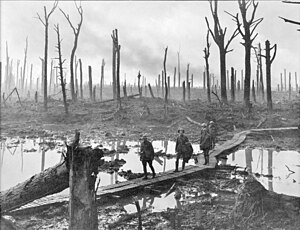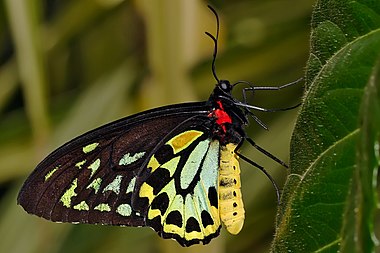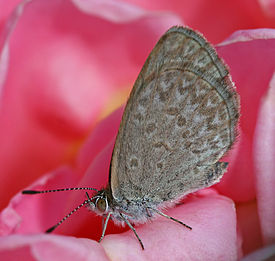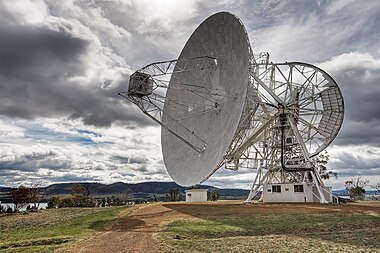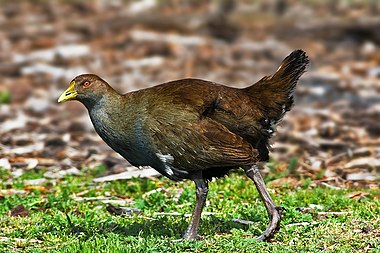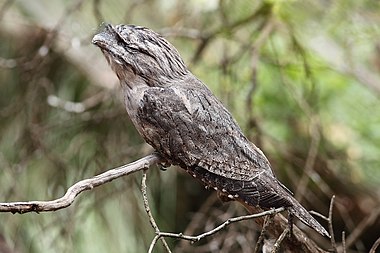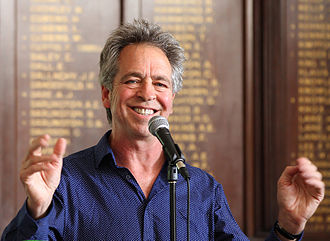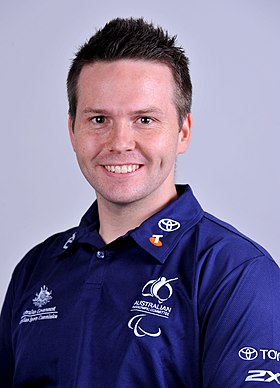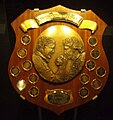Portal:Australia/sandbox
| Showcase | Content | Interesting facts | Contributing |
Introduction

Australia, officially the Commonwealth of Australia, is a country comprising the mainland of the Australian continent, the island of Tasmania and numerous smaller islands. Australia has a total area of 7,688,287 km2 (2,968,464 sq mi), making it the sixth-largest country in the world and the largest country by area in Oceania. It is the world's oldest, flattest, and driest inhabited continent, with some of the least fertile soils. It is a megadiverse country, and its size gives it a wide variety of landscapes and climates including deserts in the interior and tropical rainforests along the coast.
The ancestors of Aboriginal Australians began arriving from south-east Asia 50,000 to 65,000 years ago, during the last glacial period. By the time of British settlement, Aboriginal Australians spoke 250 distinct languages and had the oldest living culture in the world. Australia's written history commenced with Dutch exploration of most of the coastline in the 17th-century. British colonisation began in 1788 with the establishment of the penal colony of New South Wales. By the mid-19th century, most of the continent had been explored by European settlers and five additional self-governing British colonies were established, each gaining responsible government by 1890. The colonies federated in 1901, forming the Commonwealth of Australia. This continued a process of increasing autonomy from the United Kingdom, highlighted by the Statute of Westminster Adoption Act 1942, and culminating in the Australia Acts of 1986.
Australia is a federal parliamentary democracy and constitutional monarchy comprising six states and ten territories. Its population of more than 28 million is highly urbanised and heavily concentrated on the eastern seaboard. Canberra is the nation's capital, while its most populous cities are Sydney and Melbourne, both with a population of more than 5 million. Australia's culture is diverse, and the country has one of the highest foreign-born populations in the world. It has a highly developed market economy and one of the highest per capita incomes globally. Its abundant natural resources and well-developed international trade relations are crucial to the country's economy. It ranks highly for quality of life, health, education, economic freedom, civil liberties and political rights.
Featured article -
Waterfall Gully is an eastern suburb of the South Australian capital city of Adelaide. It is located in the foothills of the Mount Lofty Ranges around 5 km (3.1 mi) east-south-east of the Adelaide city centre. For the most part, the suburb encompasses one long gully with First Creek at its centre and Waterfall Gully Road running adjacent to the creek. At the southern end of the gully is First Falls, the waterfall for which the suburb was named. Part of the City of Burnside, Waterfall Gully is bounded to the north by the suburb of Burnside, from the north-east to south-east by Cleland National Park (part of the suburb of Cleland), to the south by Crafers West, and to the west by Leawood Gardens and Mount Osmond. (Full article...)
Selected biography -
Sandra Anne Morgan (born 6 June 1942), also known by her married name Sandra Beavis, or as Sandra Morgan-Beavis, is an Australian former freestyle swimmer who was part of the gold medal-winning team in the 4×100-metre freestyle relay at the 1956 Summer Olympics in Melbourne. At the age of 14 years and 6 months, she became the youngest Australian to win an Olympic gold medal, a record that was broken by Arisa Trew at the 2024 Paris Olympics. (Full article...)
Did you know (auto-generated) -
- ... that Scottish painter Gordon Coutts left Australia without paying maintenance to his estranged wife, but was arrested in New Zealand?
- ... that Georgina Sutton was the first woman to be appointed the chief pilot of an Australian airline?
- ... that Collingwood coach Robert Harvey gave Anton Tohill his AFL debut in 2021, having played International Rules Series against Tohill's father in the 1990s?
- ... that Episode 2351 of the Australian soap opera Home and Away was filmed in England, marking the first time the serial was filmed overseas?
- ... that the developers of Hotline Miami 2: Wrong Number suggested that Australian customers pirate their game?
- ... that the 2022 Optus data breach affected over a third of Australians?
- ... that the memorabilia of Jennie Scott Griffiths, a Texan who died in California, are housed in the National Library of Australia?
- ... that St Mary's Anglican Church, Busselton, Australia, has been a part of six dioceses, namely Canterbury, Calcutta, Sydney, Adelaide, Perth and Bunbury?
In the news
- 22 November 2024 – 2024 Laos methanol poisoning
- A second Australian tourist dies of alcohol poisoning in Vang Vieng, Laos, bringing the death toll from the incident to six. Eight others remain hospitalized. (ABC News Australia)
- 21 November 2024 – 2024 Laos methanol poisoning
- An Australian and a British tourist die after consuming poisoned alcohol in Vang Vieng, Laos, bringing the death toll from the incident to five. Nine others are hospitalized. (BBC News) (AP)
- 30 September 2024 – Australia–Tuvalu relations, Climate change in Tuvalu
- Tuvalu's climate minister denounces the Australian Labor government's decision to expand three coal mines as an existential threat to the nation, due to the role of the mines in causing rising sea levels that have forced mass displacement across Tuvalu's low-lying islands. (The Guardian)
- 28 September 2024 – 2024 AFL premiership season
- The Brisbane Lions defeat the Sydney Swans 120–60 in the Australian Football League Grand Final to win their fourth AFL premiership title. (The Guardian Australia)
- 26 September 2024 – Israel–Hezbollah conflict
- Israel rejects proposals from the United States, Australia, and the European Union to initiate a temporary 21-day ceasefire with Hezbollah. (Reuters) (Reuters 2)
Selected pictures -
Portal:Australia/Selected picture/1

The Yarra River is a river in southern Victoria (Australia), originally called Birrarung by the Wurundjeri people who occupied the Yarra valley prior to European settlement. The River's lower reaches travel through central Melbourne.
Portal:Australia/Selected picture/2

The Gold Coast is a coastal region approximately 70 kilometres south of Brisbane, Australia that, over the past 50 years, has coalesced from a collection of scattered villages into a city of approximately 480,000 people - currently Australia's seventh largest city - and Australia's largest tourist resort.
Portal:Australia/Selected picture/3

The Commonwealth Parliament was opened on 9 May 1901 in the Royal Exhibition Building, the only building large enough to house the 14,000 guests. Thereafter, from 1901 to 1927 it met in Parliament House, Melbourne, which it borrowed from the parliament of the state of Victoria (which sat in the Exhibition Building). On 9 May 1927 the Parliament moved to the new national capital at Canberra, where it met in what is now called Old Parliament House. Intended to be temporary, this building in fact housed the Parliament for more than 60 years. The permanent Parliament House, Canberra was opened in 9 May 1988. The scene of the opening of the first Parliament was immortalised in The Big Picture, a painting by Australian artist Tom Roberts.
Portal:Australia/Selected picture/4
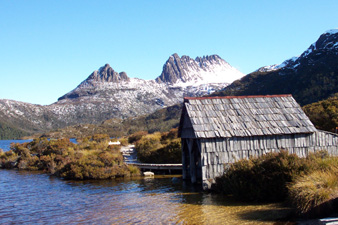
Cradle Mountain forms the northern end of the wild Cradle Mountain-Lake St Clair National Park, itself a part of the Tasmanian Wilderness World Heritage Area. The jagged contours of Cradle Mountain epitomise the feel of a wild landscape, while ancient rainforest and alpine heathlands, buttongrass and stands of colourful deciduous beech provide a wide range of environments. Cradle Mountain is a feature of the Overland Track.
Portal:Australia/Selected picture/5

The Great Ocean Road stretches along the South Eastern coast of Australia between the Victorian cities of Geelong and Warrnambool. It was built during the Great Depression, between World War I and World War II by returned servicemen as part of a government-funded job creation scheme. The Road hugs tightly to the coast and passes some of the most photogenic coastline in the world.
Portal:Australia/Selected picture/6

The Ninety Mile Beach is a sandy stretch of south-eastern coastline of Victoria, Australia which separates the Gippsland Lakes region from Bass Strait.It is believed to be the longest un-interrupted beach in the world — just over 151 kilometres (94 miles) running northeastward from a spit near Port Albert to the man-made channel at Lakes Entrance. For the northern part of its route the beach runs along a sandbar on what amounts to a series of tidal islands and behind which are several large lakes and numerous shallow littoral lagoons. The area comprises the Gippsland Lakes Coastal Park.
Portal:Australia/Selected picture/7

Joseph Benedict Chifley (September 22, 1885 - June 13, 1951), Australian politician and 16th Prime Minister of Australia, was one of Australia's most influential Prime Ministers. Among his government's accomplishments were the post-war immigration scheme under Arthur Calwell, the establishment of Australian citizenship in 1949, the Snowy Mountains scheme, the national airline Trans Australia Airlines, a social security scheme for the unemployed, and the founding of the Australian Security Intelligence Organization (ASIO). One of the few successful referendums to modify the Australian Constitution took place during his term.
Portal:Australia/Selected picture/8

The State Library of Victoria is the central library of the state of Victoria, Australia, located in the city of Melbourne. It is sited on the block bounded by Swanston, La Trobe, Russell and Little Lonsdale Streets, in the northern centre of the central business district. The Library's combined collections contain over 1.5 million books and 16,000 serials, including the diaries of the city's founders, John Batman and John Pascoe Fawkner, as well as the folios of Captain James Cook.
Portal:Australia/Selected picture/9

The Captain James Cook Memorial was built by the Commonwealth Government to commemorate the Bicentenary of Captain James Cook's first sighting of the east coast of Australia. The memorial includes a water jet located in the central basin and a skeleton globe sculpture at Regatta Point showing the paths of Cook's expeditions. On 25 April 1970, Queen Elizabeth II officially inaugurated the memorial. When running both pumps simultaneously, the main jet throws approximately six tons of water into the air at any instant, reaching a maximum height of 147 metres. Alternatively the jet can be run on a single pump reaching a lower height of 110 metres. During special occasions it can be illuminated, often with coloured lights.
Portal:Australia/Selected picture/10

The Sydney Harbour Bridge is one of the major landmarks of Sydney, Australia, connecting the Sydney central business district with the North Shore commercial and residential areas, both of which are located on Sydney Harbour. The dramatic water vista of the bridge together with the nearby Sydney Opera House (left) is an iconic image. The bridge is affectionately known as "the Coathanger" by many Sydneysiders on account of its arch-based design. It is the widest bridge in the world and also the world's largest single-arch bridge. From its official opening on 19 March 1932 until 1967, the bridge was the city's tallest structure.
Photo credit: Diliff
Portal:Australia/Selected picture/11
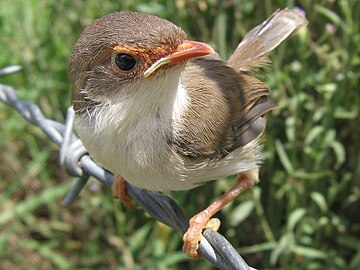
The Superb fairywren (Malurus cyaneus), commonly known as the blue wren in south-eastern Australia, is the best-known of all fairy-wrens and is endemic to Australia. It is common throughout the relatively wet and fertile crescent in the south-eastern corner of the Australian continent, from lower South Australia through all of Victoria, coastal and sub-coastal New South Wales, and Queensland as far north as the Brisbane area, and also in Tasmania. Superb Fairy-wrens occupy a wide range of habitat types and are found in almost any area that has at least a little dense undergrowth for them to shelter in, including grasslands with scattered shrubs, moderately thick forest, woodland, heaths, and domestic gardens.
Photo credit: LiquidGhoul
Portal:Australia/Selected picture/12

The Australian National Botanic Gardens are located in Canberra and are administered by the Commonwealth Government Department of the Environment and Heritage. The botanic gardens are a collection of native Australian flora arrange by taxonomy or natural ecological groupings. The gardens maintains a wide variety of botanical resources for researchers and cultivates native plants threatened in the wild. The concept for a national botanic gardens developed in the 1930s as Canberra was built, with the gardens officially opened in 1970 on a site of 90 hectares astride the Black Mountain
Photo credit: Fir0002
Portal:Australia/Selected picture/13

Melbourne is the state capital and largest city in the Australian state of Victoria, and the second-largest city in Australia, with a population of approximately 3.7 million[1] (2006 estimate). It is a coastal city located at the northern end of the Port Phillip Bay. The city's name is pronounced as either /ˈmel.bən/ or /ˈmæl.bən/. Formerly the capital city of Australia from 1901 until 1927, Melbourne is today a centre of finance and entertainment and is considered a minor world city.
Photo credit: Diliff
Portal:Australia/Selected picture/14

Mount Lofty at 727 metres is the highest point in the Mount Lofty Ranges east of Adelaide in South Australia. It was first climbed by a European when explorer Collet Barker climbed it in April 1831, almost seven years before Adelaide was settled. It had been named by Matthew Flinders on his circumnavigation of Australia in 1802.
Photo credit: Mel Mazzone
Portal:Australia/Selected picture/15
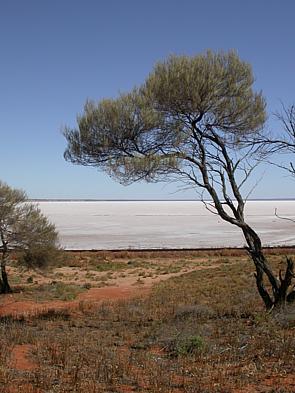
The Lake Eyre Basin has a drainage basin that covers one-sixth of all Australia. It is one of the largest internal drainage systems in the world, and covers roughly 1.2 million square kilometres, including much of inland Queensland, large portions of South Australia and the Northern Territory, and a part of western New South Wales.
Photo credit: User:Tannin
Portal:Australia/Selected picture/16

The Petrov Affair was a Cold War spy drama in Australia in April 1954, involving the defection of Vladimir Petrov, third secretary in the Soviet embassy in Canberra. Petrov's wife, Evdokia Petrova, a Russian spy, came to the centre of the affair when she was seized by Australian Security Intelligence Organisation agents from MVD agents who were escorting her from the country. Images of Petrova as she was taken by ASIO agents and made her decision to defect became iconic in Australia in the 1950s.
Photo credit: National Archives of Australia
Portal:Australia/Selected picture/17

The Australian War Memorial is the national memorial in Australia for the members of all its armed forces and supporting organisations who have died in wars. The memorial includes an extensive national military museum and is located in the capital Canberra. It is the northern terminus of the city's ceremonial land axis, which stretches from Parliament House on Capital Hill along a line passing through the summit of the cone-shaped Mt Ainslie to the northeast.
Photo credit: Fir0002
Portal:Australia/Selected picture/18

Eucalyptus is a diverse genus of trees (rarely shrubs), the members of which dominate the tree flora of Australia. There are more than 700 species of Eucalyptus, mostly native to Australia, with a very small number found in adjacent parts of New Guinea and Indonesia. Eucalypts can be found in almost every part of the continent, adapted to all of Australia's climatic conditions; in fact, no other continent is so characterised by a single genus of tree as Australia is by eucalyptus. Many, but far from all, are known as gum trees; other names for various species include mallee, box, ironbark, stringybark, and ash.
Photo credit: Fir0002
Portal:Australia/Selected picture/19

Hyde Park is a large park in the New South Wales capital of Sydney. Named after the original Hyde Park in London, it is the southernmost of a chain of parkland that extends north to the shore. It takes the form of an approximate rectangle. Around the park's boundaries lie the Supreme Court of New South Wales, Hyde Park Barracks and Sydney Hospital to the north, St Mary's Cathedral to the east and the central business district to the west. The centrepiece of Hyde Park is the majestic Archibald Fountain, unveiled in 1932 in honour of Australia's contribution to the Great War in France.
Photo credit: Greg O'Beirne
Portal:Australia/Selected picture/20

Uluru, also known as Ayers Rock, is a large sandstone rock formation in central Australia, in the Northern Territory. It is located in Uluru-Kata Tjuta National Park, 440 km southwest of Alice Springs. Uluru is sacred to the Pitjantjatjara (Aboriginal people of the area) and has many springs, waterholes, rock caves and ancient paintings. Uluru is notable for appearing to change colour as the different light strikes it at different times of the day and year, with sunset a particularly remarkable sight. The rock is made of sandstone infused with minerals like feldspar that reflect the red light of sunrise and sunset, making it appear to glow.
Photo credit: Thomas Schoch
Portal:Australia/Selected picture/21

The Weedy Sea Dragon or Common Sea Dragon (Phyllopteryx taeniolatus) is a marine fish related to the seahorse. It is the only member of the genus Phyllopteryx. They occur in water 3 to 50 metres deep round the southern coastline of Australia, approximately between Port Stephens, New South Wales and Geraldton, Western Australia, as well as around Tasmania. Weedy Sea Dragons are named for the weed-like projections on their bodies that camouflage them as they move among the seaweed beds where they are usually found.
Photo credit: Richard Ling
Portal:Australia/Selected picture/22

Byron Bay is a coastal town in the state of New South Wales of almost 30,000 people. Located approximately 800 kilometres north of Sydney and 200 kilometres south of Brisbane, the town is situated near Cape Byron at the eastern-most point of the Australian continent. The town is a popular tourist destination and is known for its pristine beaches, wildlife, alternative lifestyle and music festivals.
Photo credit: Mike Lehmann
Portal:Australia/Selected picture/23

Skyshow is an annual fireworks event held in the South Australian capital of Adelaide since 1985. The half-hour fireworks display is synchronised to pop music and presented by local commercial radio station SAFM. Originating as an Australia Day celebration, the event was subsequently moved to late summer, usually February. Although beset with serious financial difficulties in the late 1990s until rescued by the South Australian Government, it is estimated some 150,000 people attend the main festivities in Bonython Park, whilst many more watch from vantage points along the Adelaide Hills.
Photo credit: Alex Sims
Portal:Australia/Selected picture/24

Perth is the capital and most populous city of the Australian state of Western Australia. It is the fourth largest city in Australia, with a population of 1,477,818 in June 2005, making up almost 75% of Western Australia's population. It is a coastal city, located beside the Indian Ocean, and is situated on the Swan River in the lower south-western portion of the Australian continent.
Photo credit: Nachoman-au
Portal:Australia/Selected picture/25
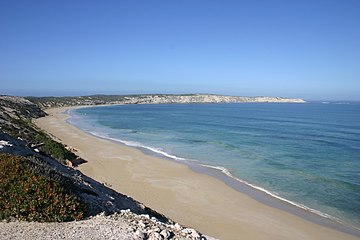
Coffin Bay is a national park in on the Eyre Peninsula of South Australia, 301 kilometres west of Adelaide, and 46 kilometres west of Port Lincoln. The township of Coffin Bay is near the entrance to the National Park. The National Park features a long peninsula with a sheltered bay, coastal dunes, swamps and a spectacular coastline of islands, reefs, limestone cliffs and white surf beaches.
Photo credit: Takver
Portal:Australia/Selected picture/26

Frederick McCubbin (25 February 1855 - 20 December 1917) was an Australian painter who was prominent in the famous Heidelberg School, one of the most important periods in Australia's visual arts history. McCubbin painted a broad range of scenes, from portraits to landscapes, but his narrative paintings of bush life were his most prominent works. His triptych (set of three paintings) The Pioneer, produced in 1906, is an iconic Australian painting. It depicts the 'selectors' who settled much of Australia's farmland in the latter years of the 19th century.
Photo credit: Frederick McCubbin
Portal:Australia/Selected picture/27

Loch Ard Gorge (38°38′S 143°04′E / 38.633°S 143.067°E) is part of Port Campbell National Park in the Australian state of Victoria. It is situated beside the Great Ocean Road, west of the popular The Twelve Apostles limestone formations. The gorge is a visible example of the process of erosion in action. It is named after the clipper ship Loch Ard, which ran aground on nearby Muttonbird Island on 1 June 1878 killing all aboard but two survivors who were washed into the gorge and found shelter.
Photo credit: Diliff
Portal:Australia/Selected picture/28

Mawson's Huts are a collection of buildings located at Cape Denison, Commonwealth Bay, in the far eastern sector of the Australian Antarctic Territory. The buildings were built and occupied by the Australasian Antarctic Expedition (AAE) of 1911-1914, led by geologist and explorer Sir Douglas Mawson. The buildings are of international heritage significance, being one of just six survivings sites from the golden age of Antarctic exploration.
Photo credit: David Killick
Portal:Australia/Selected picture/29
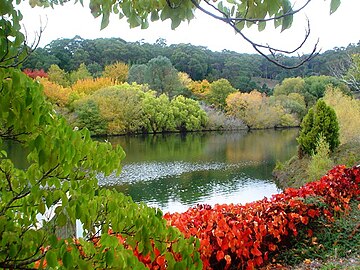
The Mount Lofty Botanic Garden is situated on a 97 hectare crescent-shaped estate on the eastern slopes of Mount Lofty in the Adelaide Hills east of Adelaide in South Australia. The cooler, wetter location suits plants from temperate climates which are difficult to grow on the Adelaide Plains. Amongst the native Australian flora are cultivated plants from cool climates including Rhododendron and Magnolia and the National Species Rose Collection.
Photo credit: Diana Quinn
Portal:Australia/Selected picture/30

Flinders Street Station is the central railway station of the suburban rail network of the Victorian capital of Melbourne. It is on the corner of Flinders and Swanston Streets next to the Yarra River in the central business district, stretching from Swanston Street to Queen Street and covering two city blocks. This 1927 photo shows a mix of motor vehicles and horse drawn carts on the streets, as well as both electric and non-electric trams. The station opened in 1910, replacing an ad hoc collection of weatherboard train sheds.
Photo credit: Victoria State Transport Authority
Portal:Australia/Selected picture/31
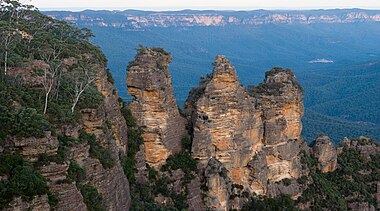
The Three Sisters are a famous rock formation in the Blue Mountains of New South Wales. Located close to the town of Katoomba in the Jamison Valley, the sandstone monuments are one of the most popular attractions in the Blue Mountains National Park. The name of each mount in order of height is Meehni (922 m), Wimlah (918 m), and Gunnedoo (906 m). The Three Sisters feature in stories of the Indigenous Australian Dreamtime.
Photo credit: Diliff
Portal:Australia/Selected picture/32

St Mary's Cathedral is the largest Roman Catholic church in Australia. It is the seat of Cardinal Archbishop George Pell and it holds the title and dignity of a Minor Basilica, bestowed upon it by Pope Pius XI in 1930. The present St Mary's is the second church of that name to occupy the site abutting College Street in Sydney. The foundation stone for the first building was laid by New South Wales Governor Lachlan Macquarie and blessed by the colony's Catholic chaplain, Father Therry, on 3 May 1821.
Photo credit: KaiAdin
Portal:Australia/Selected picture/33

The Adelaide Festival Centre is a multi-purpose arts centre in the South Australian capital of Adelaide. It is situated adjacent to Elder Park on the banks of the River Torrens, northwest of the intersection of North Terrace and King William Street. The centre is distinguished by its three silvery-white tetrahedron dome roofs and its plaza consisting of lego block-like sculptures. It was opened in 1973 by Don Dunstan as the home for performing arts in South Australia, and the centre remains the principal venue for the Adelaide Festival of Arts.
Photo credit: Michael
Portal:Australia/Selected picture/34

The Australian Alps are the highest mountain ranges of mainland Australia. They are located in south-eastern Australia, straddling far southern New South Wales and eastern Victoria. The Alps contain the Australian mainland's only peaks exceeding 2,000 metres AHD and it is only here that snow occurs regularly.
Photo credit: Fir0002
Portal:Australia/Selected picture/35
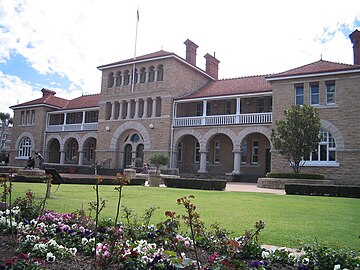
The Perth Mint is Australia's oldest operating mint. After the foundation stone was laid in 1896 by John Forrest, the Mint opened on June 20, 1899 as a branch of the Royal Mint in London to refine gold and manufacture gold sovereigns and half sovereigns to be used as currency in the colony.
Photo credit: Moondyne
Portal:Australia/Selected picture/36
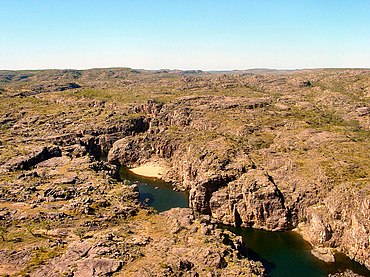
Nitmiluk National Park is a protected area in the Northern Territory of Australia. It is located 244 kilometres southeast of Darwin. Established around a series of gorges on the Katherine River and Edith Falls, the park has great ceremonial significance to the local Jawoyn people, who are custodians of Nitmiluk National Park. In Jawoyn, Nitmiluk means place of the cicada dreaming.
Photo credit: Brian Voon Yee Yap
Portal:Australia/Selected picture/37

The Story Bridge is a crossing of the Brisbane River in the Queensland capital of Brisbane. It is a six lane dual-carriageway connecting Fortitude Valley to Kangaroo Point. Designed by John Bradfield, the bridge was opened in 1940 at the height of the Great Depression. It is a Brisbane landmark, and a focus of the Riverfestival.
Photo credit: Stuart Edwards
Portal:Australia/Selected picture/38

The Sydney to Hobart Yacht Race, sometimes referred to as the Bluewater Classic, is a yacht race held over a distance of 630 nmi (1,170 km) between Sydney and Hobart. It commences on Boxing Day each year, and is hosted by the Cruising Yacht Club of Australia and Royal Yacht Club of Tasmania. The race was initially planned to be a cruise, but has grown since the inaugural race in 1945 to become one of the pre-eminent offshore yacht races in the world, now attracting maxi yachts from North America and Europe. The 2004 race marked the 60th running of the event.
Photo credit: Brian Voon Yee Yap
Portal:Australia/Selected picture/39

The Melbourne Docklands is a new inner city suburb and urban renewal project in the Victorian capital of Melbourne. The district, built on former unused docks, covers 2 km² and comprises 7 km of waterfront. It was commenced in 2000, and is expected to be completed by 2015, almost doubling the size of the central business district. Its resident population, to be comprised of primarily hi-rise apartment dwellers, is estimated to reach 20,000, while a further 25,000 will work in the area. The Docklands is already a major attraction, with landmarks such as the Telstra Dome.
Photo credit: Diliff
Portal:Australia/Selected picture/40

The Atherton Tableland is a fertile plateau which is part of the Great Dividing Range in Queensland, Australia. It is located west to south-west inland from Cairns, well into the tropics, but its elevated position provides a climate suitable for dairy farming. It has an area of around 32,000 km² with an avaerage altitude between 600 and 900m AHD. The area was originally explored for its tin and gold deposits, but today is primarily agricultural.
Photo credit: Mike Lehmann
Portal:Australia/Selected picture/41
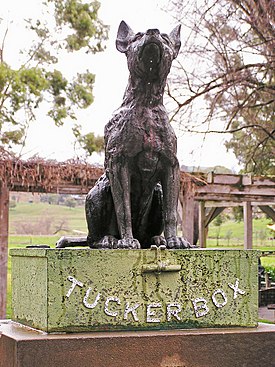
The Dog on the Tuckerbox is an Australian historical monument and tourist attraction, located at Snake Gully, eight kilometres from Gundagai in New South Wales. It was sculpted by local stonemason Frank Rusconi and was unveiled by the then Prime Minister of Australia Joseph Lyons on 28 November 1932 as a tribute to pioneers.
Photo credit: AYArktos
Portal:Australia/Selected picture/42

Government House in Perth is the official residence of the Governor of Western Australia and was built between 1859 and 1864. The building is a mansion in the Jacobean Revival style set on 3.2 hectares of English gardens in the centre of the Perth business district, between St. Georges Terrace and the Swan River. The buildings and gardens are listed on the Western Australian Register of Heritage Places and are open to the public from time to time. The building has 16 rooms on the ground floor and 25 on the first floor.
Photo credit: Greg O'Beirne
Portal:Australia/Selected picture/43
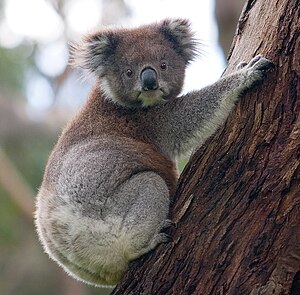
The Koala (Phascolarctos cinereus) is a thickset arboreal marsupial herbivore native to Australia, and the only extant representative of the family Phascolarctidae. It is found all along the eastern coast of Australia from near Adelaide to the southern part of Cape York Peninsula, and as far into the hinterland as there is enough rainfall to support suitable forests.
Photo credit: Diliff
Portal:Australia/Selected picture/44
This note, denominated twenty pounds, is part of the 1918 series.
See other denominations: 10 shillings (1918) · £1 (1918) · £5 (1918) · £10 (1918) · £50 (1918) · £100 (1918) · Half sovereign (1923) · £1 (1923) · £5 (1924) · £10 (1925)Portal:Australia/Selected picture/45

A notice of an £8000 pound reward for the capture of the Kelly gang, which included Ned Kelly, Dan Kelly, Joe Byrne, Steve Hart, Kate Kelly.
Source: National Archives
Portal:Australia/Selected picture/46

The Kiewa River is a major tributary of the Murray River in Australia and the source of approximately 40% of the Murray's flow. The river's headwaters include Victoria's highest mountain, Mount Bogong, and wind their way north-west about 100 kilometres, gradually slowing before joining the Murray west of Albury.
Photo credit: Mattinbgn
Portal:Australia/Selected picture/47
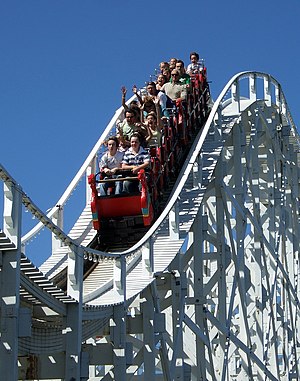
Luna Park is an amusement park located on the foreshore of Port Phillip Bay in St Kilda, Victoria, which is an inner suburb of Melbourne, Australia. It opened in 1912 and has been operating since. It is the first of two Luna Parks still operating in Australia; the other is on Sydney Harbour.
Photo credit: Stevage
Portal:Australia/Selected picture/48

The Eastern Banjo Frog, Limnodynastes dumerilli, is a frog species from the family Myobatrachidae. It is native to eastern Australia and has been introduced to New Zealand. The frog is also commonly called the "pobblebonk" after its distinctive "bonk" call, which is likened to a banjo string being plucked.
Photo credit: Fir0002
Portal:Australia/Selected picture/49
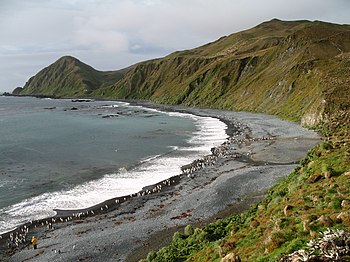
Macquarie Island lies in the southwest corner of the Pacific Ocean, about half-way between Australia and Antarctica. Politically, it has formed part of the Australian state of Tasmania since 1900 and became a Tasmanian State Reserve in 1978. In 1997 it became a World Heritage Site. The Australian Antarctic Division (AAD) maintains a permanent base on the island. The base's residents, the island's only inhabitants, range in numbers from 20 to 40 people throughout the year.
Photo credit: M. Murphy
Portal:Australia/Selected picture/50

Taronga Zoo is the zoological park of the city of Sydney. Founded in 1916, it is located on the shores of Sydney Harbour in Mosman. It is divided into eight zoogeographic regions and features over 2,600 animals on 28.7 hectares, making it one of the largest zoos of its kind.
Photo credit: Jan Derk
Portal:Australia/Selected picture/51

Blue Lake is a large lake located in an extinct volcanic caldera in Mount Gambier. It is known as Waawor in the local Aboriginal language. During summer and the surrounding months, the lake takes on a vibrant blue colour, returning to a colder steely-grey colour for winter. The exact cause of this phenomenon is still a matter of conjecture but it is generally considered likely that it revolves around the warming of the surface layers of the lake during the summer months to around 25 degrees celsius, causing calcium carbonate to precipitate out of solution and enabling micro-crystallites of calcium carbonate to form. This results in a scatter of the blue wavelength of sunlight. The movement of planktonic life-forms within the lake during the seasons and during the day may also play a part in the visibility changes.
Photo credit: Aaron Allen
Portal:Australia/Selected picture/52

The Art Gallery of South Australia located in Adelaide is the most significant visual arts museum in the Australian state of South Australia. It has a collection of almost 45,000 works of art, making it the second largest state art collection in Australia (after the National Gallery of Victoria).
Photo credit: K. Lindstrom
Portal:Australia/Selected picture/53
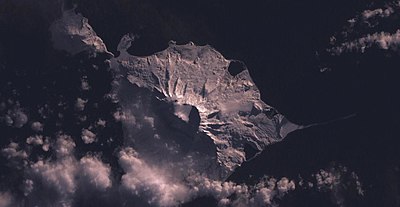
Heard Island and McDonald Islands is an Australian territory comprising uninhabited, barren islands in the Southern Ocean, about two-thirds of the way from Madagascar to Antarctica. The islands have been a territory of Australia since 1947 and became a World Heritage Site in 1997. It contains the only two active volcanoes in Australian territory, one of which, Mawson Peak, is the highest Australian mountain.
Photo credit: NASA World Wind
Portal:Australia/Selected picture/54

The Pinnacles Desert is an area of unique limestone formations within the Nambung National Park in Western Australia. The desert contains many thousands of pillars, which rise up to five metres, with shape and texture having been defined by calcification processes and erosion. Since The Pinnacles was incorporated into the national park in the 1960s, the area has become significant tourist attraction.
Photo credit: Sean Mack
Portal:Australia/Selected picture/55

Yulara is an isolated town in the Northern Territory of Australia. At the 2016 census, Yulara had a permanent population of 1,099 in an area of 103.33 square kilometres (39.90 sq mi). It is 18 kilometres (11 mi) by road from the World Heritage Site Uluru (Ayers Rock) and 55 kilometres (34 mi) from Kata Tjuta (the Olgas).
Photo credit: Manfred Wiesinger
Portal:Australia/Selected picture/56

Hakea is a genus of about 150 species of plants in the Family Proteaceae, endemic to Australia. Hakeas are found in every state of Australia with the highest species diversity being found in the south west of Western Australia.
Photo credit: Fir0002
Portal:Australia/Selected picture/57

The Australian 11th Battalion was an Australian Army unit in World War I. It was among the first infantry units raised for the First Australian Imperial Force during the war and was the first battalion recruited in Western Australia. Along with the 9th, 10th and 12th Battalions, it formed the 3rd Brigade. By the end of the war, the Battalion suffered casualties of 1,115 killed and 2,249 wounded (including gassed). Prior to the Gallipoli landing, the Battalion was posted in Egypt.
Photo credit: Unknown
Portal:Australia/Selected picture/58

The Grampians is a mountain range and national park in Victoria, located 235 kilometres west of Melbourne. The ranges were named in 1836 by Surveyor-General of New South Wales, Sir Thomas Mitchell, after the Grampian Mountains in his native Scotland, but are also known by the name Gariwerd, from one of the local Australian Aboriginal languages.
Photo credit: Stevage
Portal:Australia/Selected picture/59
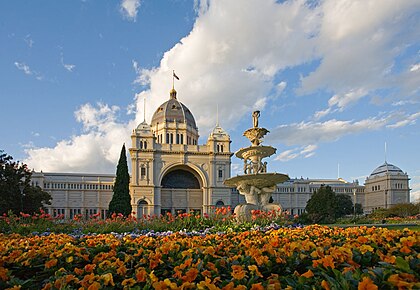
The Royal Exhibition Building is located in Victorian capital of Melbourne. Situated in the Carlton Gardens, at the north-eastern edge of the central business district, it was completed in 1880 for the Melbourne International Exhibition. It was also the site of the inauguration of the Commonwealth of Australia with the opening of the first Parliament of Australia.
Photo credit: Diliff
Portal:Australia/Selected picture/60

The Common Eastern Froglet (Crinia signifera) is a very common, Australian ground-dwelling frog, of the family Myobatrachidae. It ranges from south-eastern Australia, from Adelaide to Melbourne, up the eastern coast to Brisbane. It also inhabits a majority of Tasmania. It is a small frog (3 centimetres), of brown or grey colour of various shades. It has extremely variable markings, with great variety usually found within confined populations
Photo credit: LiquidGhoul
Portal:Australia/Selected picture/61

An Australian meat pie is a hand-sized pie containing largely minced meat and gravy and often consumed as a takeaway food snack. It is considered iconic and has been described by many, including former New South Wales Premier Bob Carr, as Australia's "national dish". Photo credit: Fir0002
Portal:Australia/Selected picture/62

The red-winged fairy-wren (Malurus elegans) is a species of passerine bird in the family Maluridae. It is sedentary and endemic to the southwestern corner of Western Australia. Exhibiting a high degree of sexual dimorphism, the male adopts a brilliantly coloured breeding plumage, with an iridescent silvery-blue crown, ear coverts and upper back, red shoulders, contrasting with a black throat, grey-brown tail and wings and pale underparts. Photo credit: Cas Liber
Portal:Australia/Selected picture/63

Lamington National Park is a 206 square kilometre conservation area situated on the Lamington Plateau in Queensland, 75 kilometres south of Brisbane. It is part of the World Heritage site, Central Eastern Rainforest Reserves. Most of the park is situated 900 m above sea level only 30 km from the Pacific's ocean shores. The plateau and cliffs, remnants of a huge volcano, remain one of the world's most special sanctuaries.
Photo credit: Malcolm Jacobson
Portal:Australia/Selected picture/64

Portal:Australia/Selected picture/65

The Happy Valley Reservoir is a water reservoir located in Adelaide, Australia. Constructed when the total population of Adelaide numbered 315,200 (1893 census), the Happy Valley Reservoir now supplies over a half a million people, from Adelaide's southern extent to the city-centre.
Photo credit: Ctbolt
Portal:Australia/Selected picture/66

Photo credit: Petesmiles
Portal:Australia/Selected picture/67

Sturt's Desert Pea is an Australian plant in the genus Swainsona. One of Australia's best-known wildflowers, it is known for its distinctive blood-red leaf-like flowers, each with a bulbous black centre, or "boss". It is native to the arid regions of central and north-western Australia, and its range extends into all mainland Australian states with the exception of Victoria. It is the floral emblem of South Australia.
Photo credit: Fir0002
Portal:Australia/Selected picture/68

The Australian wine industry is one of the world's largest exporters of wine, with approximately 800 million out of the 1.2 to 1.3 billion litres produced annually exported to overseas markets. The wine industry is a significant contributor to the Australian economy through production, employment, export, and tourism.
Photo credit: Fir0002
On this day

- 1880 – Redmond Barry, the judge who sentenced Ned Kelly to be hanged, died just twelve days after Kelly was hanged.
- 1932 – The statue of The Dog on the Tuckerbox is unveiled at Gundagai, New South Wales by Prime Minister Joseph Lyons.
- 1955 – The Cocos Islands come under Australian control.
- 1961 – Cricketer Merv Hughes is born.
General images
Topics
More portals
WikiProject
 |
 |
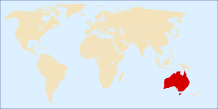
| |
Consider joining WikiProject Australia, a WikiProject dedicated to improving Wikipedia's coverage of topics related to Australia. The project page and its subpages contain suggestions on formatting and style of articles, which can be discussed at the project's notice board. To participate, simply add your name to the project members page.
As of 23 November 2024, there are 205,613 articles within the scope of WikiProject Australia, of which 594 are featured and 886 are good articles. This makes up 2.97% of the articles on Wikipedia, 5.33% of all featured articles and lists, and 2.18% of all good articles. Including non-article pages, such as talk pages, redirects, categories, etc., there are 526,478 pages in the project.
Associated Wikimedia
The following Wikimedia Foundation sister projects provide more on this subject:
-
Commons
Free media repository -
Wikibooks
Free textbooks and manuals -
Wikidata
Free knowledge base -
Wikinews
Free-content news -
Wikiquote
Collection of quotations -
Wikisource
Free-content library -
Wikiversity
Free learning tools -
Wikivoyage
Free travel guide -
Wiktionary
Dictionary and thesaurus




